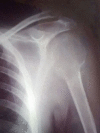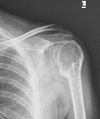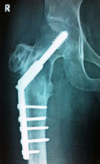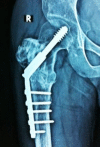'Salvage Treatment' of Aggressive Giant Cell Tumor of Bones with Denosumab
- PMID: 26251767
- PMCID: PMC4524749
- DOI: 10.7759/cureus.291
'Salvage Treatment' of Aggressive Giant Cell Tumor of Bones with Denosumab
Abstract
Giant cell tumor of the bone (GCTB) presents as a lytic lesion of epiphyseometaphyseal regions of the long bones usually during the second to the fourth decade with female predilection. Histologically, they are formed of neoplastic mononuclear cells with a higher receptor activator of nuclear factor kappa-B ligand (RANKL) expression responsible for the aggressive osteolytic nature of the tumour. RANKL helps in the formation and functioning of osteoclasts. A newer molecule, Denosumab, is a monoclonal antibody directed against RANKL and thus prevents the formation and function of osteoclasts. Management of refractory, multicentric, recurrent, or metastatic GCTB remains challenging as achieving a tumor-free margin surgically is not always possible. Denosumab may play a crucial role, especially in the management of such difficult lesions. We present three cases of locally aggressive GCTB (involving proximal humerus, sacrum, and proximal femur) that were treated and responded very well to Denosumab therapy.
Keywords: denosumab; giant cell tumor of bone; rankl.
Conflict of interest statement
The authors have declared that no competing interests exist.
Figures








References
-
- Giant cell tumor of bone. Mendenhall WM, Zlotecki RA, Scarborough MT, Gibbs CP, Mendenhall NP. Am J Clin Oncol. 2006;29:96–99. - PubMed
-
- RANKL, denosumab, and giant cell tumor of bone. Thomas DM. Curr Opin Oncol. 2012;24:397–403. - PubMed
-
- Expression of osteoclast differentiation signals by stromal elements of giant cell tumors. Atkins GJ, Haynes DR, Graves SE, Evdokiou A, Hay S, Bouralexis S, Findlay DM. J Bone Miner Res. 2000;15:640–649. - PubMed
-
- RANK expression as a cell surface marker of human osteoclast precursors in peripheral blood, bone marrow, and giant cell tumors of bone. Atkins GJ, Kostakis P, Vincent C, Farrugia AN, Houchins JP, Findlay DM, Evdokiou A, Zannettino AC. J Bone Miner Res. 2006;21:1339–1349. - PubMed
Publication types
LinkOut - more resources
Full Text Sources
Other Literature Sources
